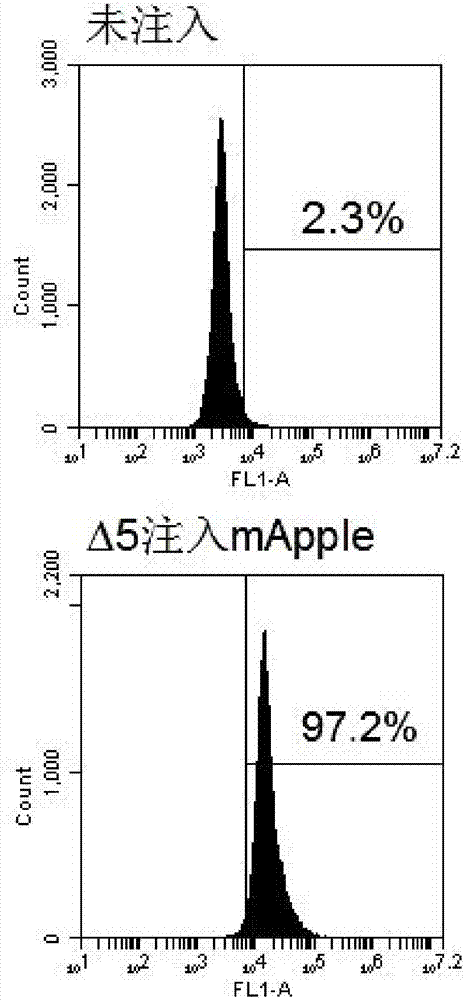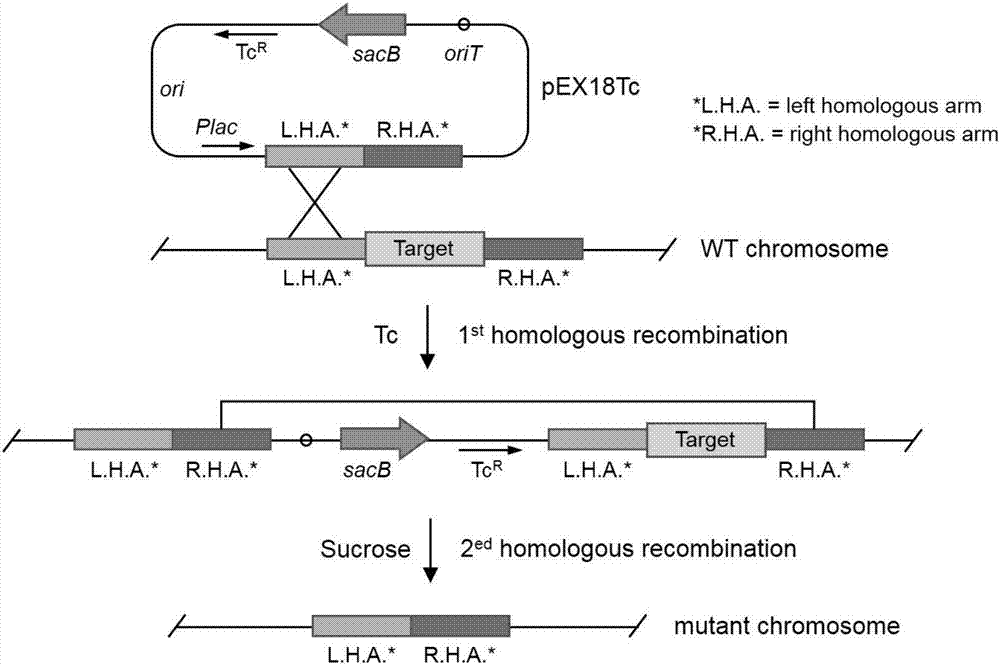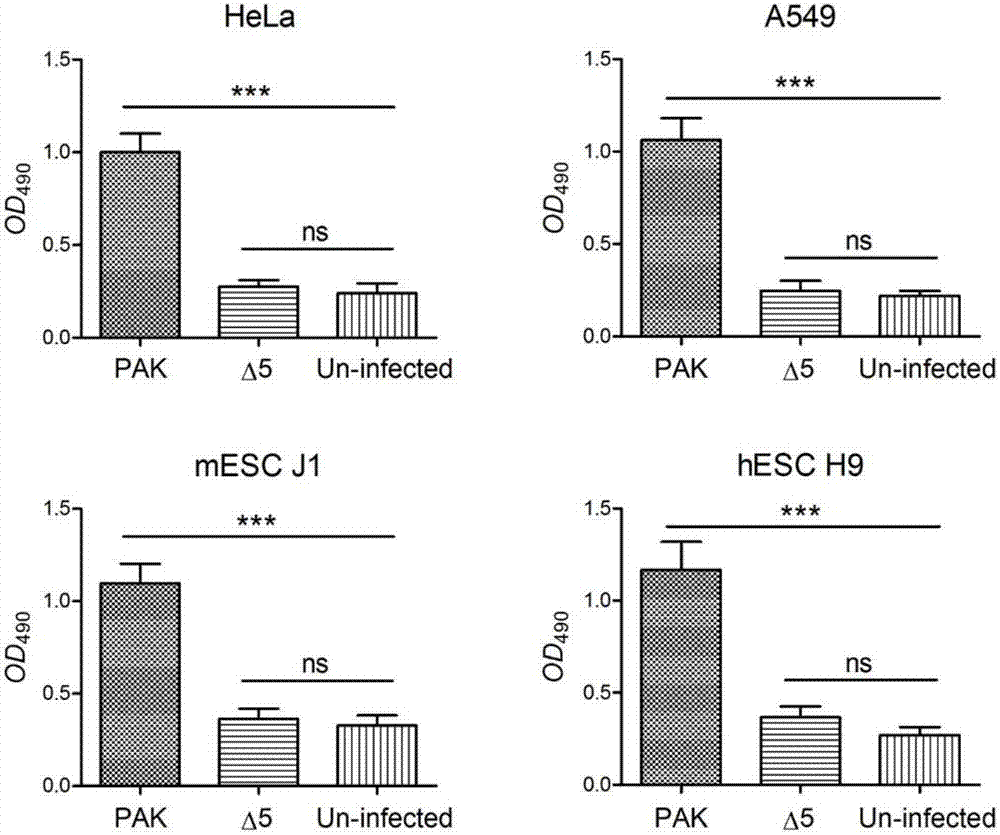Construction method and applications of engineering strain for delivering mammalian cell protein
A technology of mammals and engineering strains, applied in the biological field, can solve problems such as inapplicability to large-scale production, cumbersome operation, and carcinogenesis induced by exogenous nucleic acid fragments, and achieve an effect suitable for large-scale production
- Summary
- Abstract
- Description
- Claims
- Application Information
AI Technical Summary
Problems solved by technology
Method used
Image
Examples
Embodiment 1
[0058] Embodiment 1. Construction of genetic engineering strain Δ5
[0059] Using the genomic DNA of the PAK strain as a template, about 1-kb homology arm fragments upstream and downstream of exoS, exoT, exoY, ndk and popN were amplified by PCR. The above PCR products were digested and cloned into plasmid pEX18Tc to construct gene knockout plasmids pEX18Tc-exoS, pEX18Tc-exoT, pEX18Tc-exoY, pEX18Tc-ndk and pEX18Tc-popN. The knockout plasmids stored in DH5a were extracted, and the plasmids were transformed into Escherichia coli S17 competent cells by chemical transformation method. The gene knockout plasmid in S17 was transferred into the PAK strain by conjugative transfer method, and the exoS, exoT, exoY, ndk and popN genes in the PAK genome were knocked out one by one. The principle of gene knockout is as figure 1 As shown, single-crossover strains with homologous recombination in one homologous arm were screened on an agarose plate containing 50 μg / mL tetracycline, and homo...
Embodiment 2
[0060] Example 2. Cytotoxicity of Genetic Engineering Strain Δ5 to Various Mammalian Cells
[0061] The wild-type strain PAK and the genetically engineered strain Δ5 were selected as infection strains, and their cytotoxicity against mammalian cells HeLa, A549, mouse embryonic stem cells (mESC) J1 and human embryonic stem cells (hESC) H9 were compared. Cytotoxicity was detected by lactate dehydrogenase (LDH) cytotoxicity detection kit. When the cells are damaged, the enzymes in the cytoplasm will be released into the culture medium, including lactate dehydrogenase LDH with relatively stable enzyme activity. Under the action of lactate dehydrogenase, NAD + It is reduced to NADH, and NADH is catalyzed to generate a strong chromogenic substance, which produces an absorption peak at a wavelength of 490nm. The quantitative analysis of cytotoxicity can be realized by quantifying the activity of LDH through colorimetry. Culture HeLa, A549, mESCJ1 and hESCH9 cells to 70-80% cell densi...
Embodiment 3
[0062] Example 3. Inject mApple protein into HeLa cells using genetically engineered strain Δ5
[0063] The mApple gene was amplified by PCR and cloned into the expression vector pExoS 54 In this method, the target protein (mApple) to be injected and the T3SS secretion signal peptide ExoS 54 Fusion, constructed into the expression vector pExoS 54 -mApple( image 3 ). The expression vector was electrotransformed into Pseudomonas aeruginosa Δ5 strain to construct mApple delivery strain Δ5 / pExoS 54 -mApple. After the strain contacts the target cells, its T3SS is activated, and the bacterial expression vector pExoS 54 -mApple expresses ExoS efficiently 54 -mApple fusion protein, which can be injected into target cells through T3SS. ExoS 54 There is a Flag tag behind the sequence, so the expression of fusion protein can be detected by WesternBlot method. Such as Figure 4 showed that the exogenous protein mApple can secrete the signal ExoS at the T3SS 54 Injected into HeLa...
PUM
| Property | Measurement | Unit |
|---|---|---|
| pore size | aaaaa | aaaaa |
Abstract
Description
Claims
Application Information
 Login to View More
Login to View More - R&D
- Intellectual Property
- Life Sciences
- Materials
- Tech Scout
- Unparalleled Data Quality
- Higher Quality Content
- 60% Fewer Hallucinations
Browse by: Latest US Patents, China's latest patents, Technical Efficacy Thesaurus, Application Domain, Technology Topic, Popular Technical Reports.
© 2025 PatSnap. All rights reserved.Legal|Privacy policy|Modern Slavery Act Transparency Statement|Sitemap|About US| Contact US: help@patsnap.com



